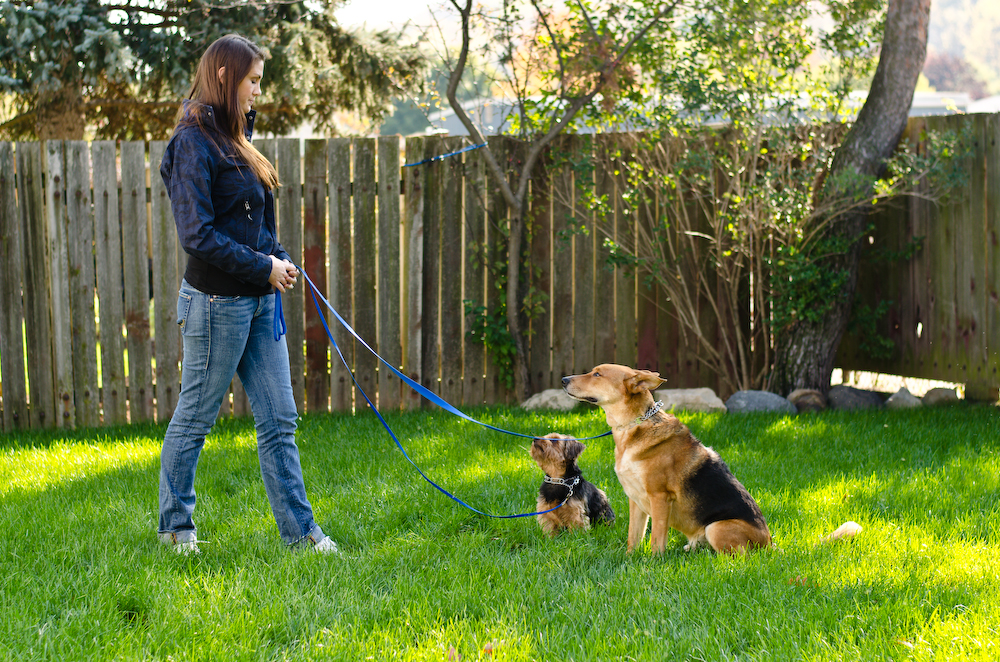by The Crunchy Canine | Nov 15, 2015 | BLOG
The flexi-lead is one tool I would not be sad to see die. Actually, I would be through the roof, singing, and dancing happy if the flexi-lead was never sold in another store again. Now, I will let you in on a deep dark secret of mine…I have used a flexi-lead in the past. I don’t often admit this but now you know! So I can understand why the average dog owner would think the flexi-lead is an awesome tool. What’s NOT awesome about it though? Everything! The people who buy flexi-leads often fall into one of two categories. The first being dog owners whose dogs pull incessantly and they think the fix is giving the dog more leash so they don’t no longer pull. The second type is the dog owner who thinks their dog needs more freedom and gets more exercise using the flexi-lead. Unfortunately neither of these reasons are reasons to use a flexi-lead. Very rarely does a flexi-lead fix pulling…the dog will usually still end up pulling but 15ft in front instead of 4 or 6ft ahead. As for more exercise, having your dog walk nicely by your side will burn more physical and mental energy than letting him wander all over the place. There are actually a few more reasons I despise the flexi-lead:
They have been known to break (personal experience with this one)
They constantly put pressure on your dogs neck even if they aren’t pulling because the leash is always in retract mode (unless you lock it – but then that defeats the purpose of a flexi right?)
With your dog 15-20ft ahead of you, you have no control over their actions. Dogs are getting hit by cars while on a flexi-lead because they darted on to the road to try to get to something they wanted (such as another dog, squirrel, kids etc.). Also, if your dog turns the corner 15-20ft before you, not only do you not know what is around that corner putting your dog in potential danger, but it is not fair to others who might be approaching that corner. There may be a dog who is not great with other dogs around that corner, there may be someone who is scared of dogs, or kids playing. Not only do you need to keep your dog safe but you need to offer some common courtesy to those in your neighbourhood and not let your dog rush them on a flexi-lead.
I will not allow a client to have their dog on a flexi-lead during our sessions. I only use 4 or 6ft leads unless I am training the recall (coming when called) when I use a flat nylon 20ft training leash. If you need help transitioning from a flexi-lead to a regular leash please give me a call!
Happy Training!
Katherine
Canines In Balance
Hamilton, Ontario
by The Crunchy Canine | Nov 10, 2015 | BLOG
 When training your dog there are three important components that you need to keep in mind when practicing to ensure your dog can still perform the task regardless of it’s surroundings. Those components are called the 3 D’s of training.
When training your dog there are three important components that you need to keep in mind when practicing to ensure your dog can still perform the task regardless of it’s surroundings. Those components are called the 3 D’s of training.
So what are the 3 D’s?
1. Duration dog training tips
2. Distance dog training tips
3. Distraction dog training tips
Duration – We always start with duration as the first of the D’s to practice. For example, this means that your dog should be able to hold a sit with you right beside him for a good amount of time before you add distance or distractions. A good test to gage whether your dog is ready to move on to the next D is asking for a sit or down, and he needs to be able to hold the sit or down for 2 minutes without needing to be corrected while you stand right beside him. If he can handle that, then you can move on to the next D!
Distance – Once duration has been established, you can move on to practicing distance. This is where you would ask your dog to sit or down, and then walk away from him. Start slow with only a few feet between you and your dog, while working your way back up to 2 minutes like you did with duration. You will gradually increase the distance and duration as you practice more.
Distraction – Having a dog who sits when you ask him to in your house with little to no distractions is great, but what happens when you go outside and there are sights and smells that interest him? This is where you want to continue to practice the above two D’s while gradually increasing the distractions. Start with low level distractions, so as not to set the bar too high and out of reach. As your dog begins to be able to handle low level distractions you can increase the level of distraction to something that would normally really excite him.
If you practice all of your commands keeping the 3 D’s in mind, you will have a dog who listens no matter where he is and not matter what is going on around him! Remember to be patient and if he makes a mistake fix it and learn from it.
Happy training!
Dog training tips

by The Crunchy Canine | Nov 8, 2015 | BLOG
Crate training is an invaluable tool that all dog owner’s should use. Not only does it keep your dog safe while you are not home, it provides them with much needed down time, structure, and the ability to be calm in a small space (can come in handy if your dog ever needs veterinary care and needs to stay overnight, or be kenneled while you go on vacation). puppy crate training
How to start:
Make sure you have the right sized crate. The dog should have enough room to get up and turn around, that is it. uppy crate training
Choose your bedding wisely. If your dog is destructive, do not leave any bedding in the crate.
Start with short intervals in the crate while you are home. Put your dog’s leash on, guide them to the crate and say “in your crate”. Use the leash to help guide him in. Once in give him a reward, and shut the door. Wait 1 minute, open the door but do not let him charge out. If he tries to run out close the door quickly. Repeat until you can open the door without him trying charge out. Once you can open the door and he remains in the crate, wait for him to look at you and you can say “OK” to release him.
Start feeding your dog in his crate to make more positive associations to the crate. Same rule above applies though when letting him out.
Start to increase the amount of time in his crate while you are home.
If your dog whines or barks while in the crate you need to correct it. Try to correct it in the very early stages before he works himself up. You can correct it verbally with a sharp “eh eh”, visit the dollar store and get a spray bottle and correct with a squirt of water, pick up a Pet Corrector from the pet store (can of air that makes a loud “shhht” noise to interrupt unwanted behaviour), or tap the top of the crate with your hand.
Follow these protocols for a week and start to leave him in the crate while you leave the house. When you put him in do not say anything other than “in your crate”. Do not feel bad, or sorry that you are leaving him. He can sense your emotions and this makes things worse for dogs who have some separation anxiety. puppy crate training
When you return do not speak to the dog, follow the protocol for letting him out of his crate. Do not give him any attention for 10 minutes after you get home (no touch, not talk, no eye contact). Only once he is completely calm can you give him attention. puppy crate training
By following these steps you should successfully be able to crate train your dog!
If you need help with crate training your puppy contact us today! 905-869-1170 or info@caninesinbalance.ca
Happy Training!
Katherine
by The Crunchy Canine | Nov 2, 2015 | BLOG
I so often hear people refer to their dogs as their “fur babies” or “four legged kids”…these sayings usually make us dog trainers cringe. When I hear these terms of endearment for dogs (because, hey that’s what they are right? Dogs!), what I am really hearing is someone who has humanized their dog. Someone who could never possibly say no to this cute, furry, creature. Someone who could never hold a dog acountable for their own actions. Now, this may not be true for all people who use the term “fur baby”, and I hate to paint everyone with the same brush. However, 9 times out of 10 that is what you get.
So where am I going with this? And why on earth would I not be OK with the term “fur baby” but want people to treat their dogs more like their kids? Well let’s look at the average day of a 10 year old kid (which would translate to a dog who is about one year to one and half years old). Said kid gets up at 7am to get ready for school, he has breakfast, brushes his teeth, gets dressed, makes his bed, packs his bag, and this is all before 8am. Then he heads off to catch the bus, has a full day of learning and socializing with his peers before catching the bus to come home. Then he gets home, unpacks his lunch bag, completes his homework, has dinner, helps with the dishes, cleans his room, and then possibly some free time before getting ready for bed. Now this is just a 10 year old kid…as he gets older his schedule gets busier, his responsibilities increase, he is held accountable for his actions. See where I am going with this yet?
Now lets look at the average day of a one year old dog…Get up, human lets him outside, human feeds him, human lets him drag them around the block, sniffing every slice of grass he can, human goes to work and either leaves the dog free to get into whatever trouble they can find or hopefully crates him. Rinse and repeat for the evening (and this dog is lucky if he gets two walks a day even if they aren’t structured like we would hope). Somewhere inbetween all of this, the human is likely giving way too much love and affection rather than leadership and structure.
So what would happen if we started to ask our dogs for a little more? I often tell clients to think of it this way…Life is not always a party, so lets stop letting our dogs think it is. It is OK to ask your dog to be held accountable for their actions. It is OK to ask your dog to be calm while you are eating dinner. It is OK to not allow your dog to jump all over people when they come to your house. We don’t let our kids run around doing whatever they please, so why would we let our dogs? At this point the wheels might be turning, and you are thinking “OK she’s on to something here…but HOW do I do this?”. It really can be quite simple. Here are a few things you can change today that will make a huge difference in yours and your dogs life:
1) Follow the Nothing In Life Is Free theory – meaning everything your dog wants he must do something for (ie. Before a meal he must sit and wait politely, when he wants to be pet he must sit quietly beside you not pushing his head under your hand, he must be invited up on to the furniture if he has earned the right to being on it and he is not allowed to be a jerk if asked to get off etc.)
2) Two structured walks EVERY day. This means walking nicely beside you, not dragging you around the block.
3) Teaching him to stay still and relax. I use “place” for this, where I teach a dog to go lay down on their bed when I need them out of the way. Perfect for cooking, eating, having guests over, or just when you need them out of the way. The “place” command will literally transform your dogs life!
4) Waiting before going through thresholds. Not allowing him to bolt out the door by asking him to sit and wait even if the door is opened.
Those are just 4 things you can do to get started. So let’s all try to treat our dogs more like our human kids and less like our “fur babies”!

by The Crunchy Canine | Oct 30, 2015 | BLOG
So your dog is not listening to you…and I bet you are getting more frustrated by the day! Here are the top 3 reasons your dog does not listen to you:
1. He does not understand what you are asking of him. Imagine travelling to Germany and not speaking a single word of German. You get off the plane and someone starts speaking to you in German. You don’t understand what they are saying. They repeat themselves a few times, obviously getting more frustrated that you are not replying. Now apply that to your dog. Telling your dog to “sit” when he doesn’t know what “sit” means, you might as well be speaking German to him!
2. He understands what you are asking of him but doesn’t think you actually mean it. If you have kids you have probably found them watching TV yet they have a messy room. You ask them to go clean their room. They ignore you and continue watching TV. You ask again. Still they ignore you and continue watching TV. Do you follow through and make them clean their room? If you ask your dog to sit, follow through and make them sit. If you don’t have the means to make them follow through (ie. maybe your dog walks away when you ask him to sit), then put the leash on and have him follow through. Often dogs don’t listen because they don’t take you seriously. If last time you asked him to sit and he didn’t but you never followed through, then your dog doesn’t think you mean it. So if you say sit, mean it!
3. You’re asking more than he can handle at his current level of training. You may have heard me talk about the 3 D’s of training. They are Duration, Distance, and Distraction. In order for your dog to be able to sit and hold the sit with distractions (ie another dog in sight), you need to practice! Once he can handle the commands with little to no distractions then you can slowly add them. You can also layer distance and duration into the equation, but all with PRACTICE!
So now that you know the top 3 reasons your dog does not listen, work on fixing these issues and I bet your dog will start listening to you a lot better!
Happy Training!
Katherine
Canines In Balance
Hamilton, Ontario

 When training your dog there are three important components that you need to keep in mind when practicing to ensure your dog can still perform the task regardless of it’s surroundings. Those components are called the 3 D’s of training.
When training your dog there are three important components that you need to keep in mind when practicing to ensure your dog can still perform the task regardless of it’s surroundings. Those components are called the 3 D’s of training.
